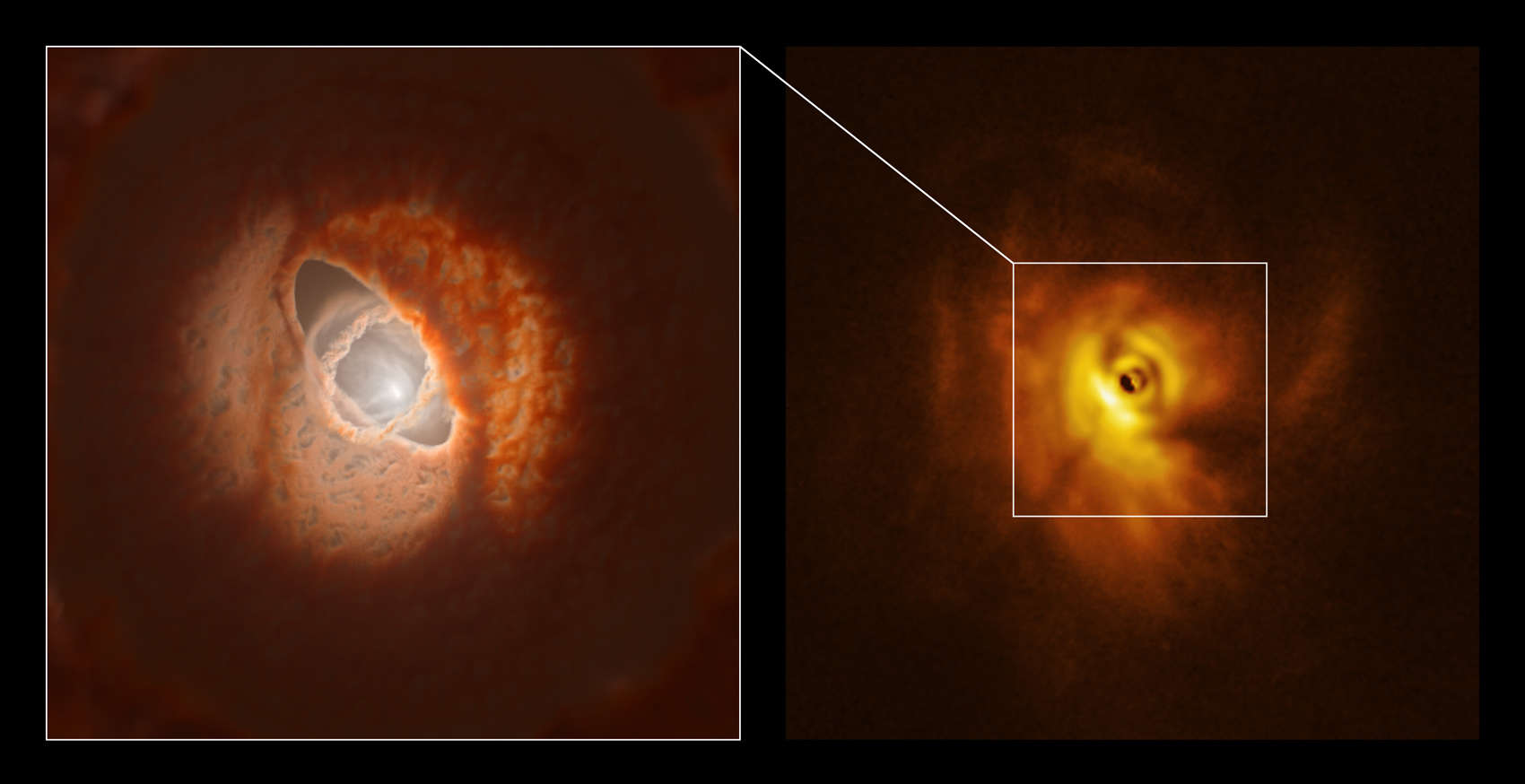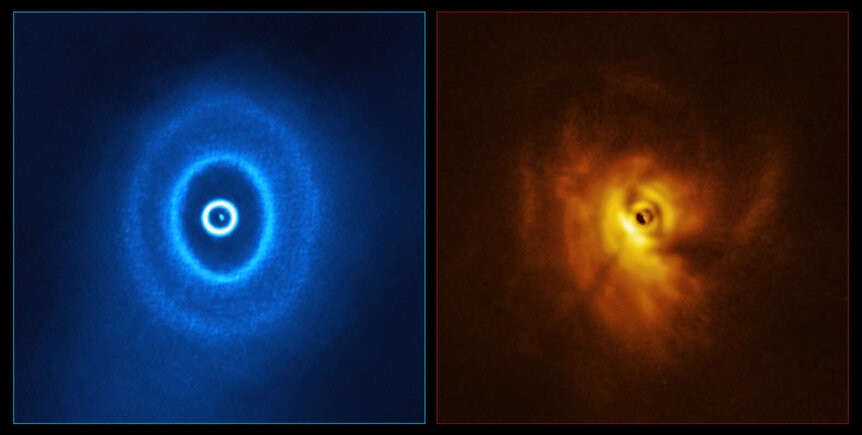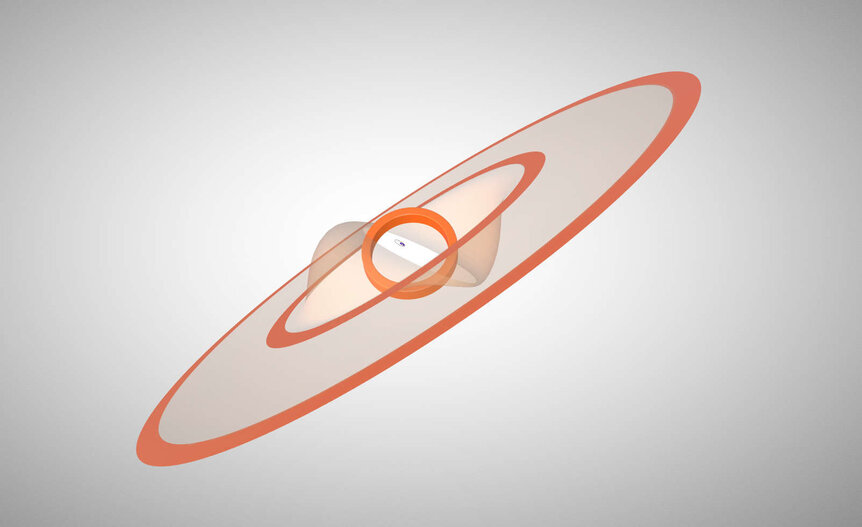Create a free profile to get unlimited access to exclusive videos, sweepstakes, and more!
A triple-star gravitational dance creates ridiculously complex sculptures

Stars form when clouds of gas and dust fragment and collapse, forming flat disks of material that feed the young stars' growth. Many times, even most times, this creates multiple stars, two or more stars orbiting each other. Models have predicted that triple stars (called trinaries) can, through the stars' gravities, carve bizarre and fantastic shapes in the disks around them.
And now, for the first time, astronomers have seen exactly that. And it's… well, bizarre and fantastic.
GW Orionis is a multiple star about 1,300 light years away in the constellation of Orion. This is a very young system, just about a million years old (the Sun is 4,500 times older, for comparison), and still surrounded by the gas and dust from which it formed.
GW Ori is a what's called a hierarchical triple: Two stars orbiting each other closely, 180 million kilometers apart (comparable to Earth's orbit around the Sun), with a third star orbiting the two much farther out, about 1.2 billion kilometers away. But here's the important bit: They don't all orbit in the same plane. The third outer star's orbit is highly tilted with respect to that of the two inner stars.
This means the gas surrounding the stars has a peculiar and complex set of gravitational forces acting on it, and that has profoundly changed its shape. Far out from the stars the gas is in a flat disk. But closer in, where the changing interplay of gravity is stronger, the disk has been distorted, even torn apart.
The changing gravity has caused the gas to separate into a system of rings, and they are very weird. There are two rings of cold gas very far out from the stars, 27 and 50 billion kilometers, and they're tilted to our line of sight, so they appear elliptical. They're centered on the center of mass of the trinary system, the point that all three stars move around (like the center of balance in a seesaw).
Those two rings are coplanar (aligned with each other in the same plane) but highly tilted to the stars in the center. It's not clear why, but it could be due to turbulence in the gas as it fragmented to form the rings, or a big torque from a passing nearby star — GW Ori is part of a cluster of stars, so nearby passes of other stars may be common. It's also possible that planets are forming out there in the disk, which could also affect how they're being sculpted.
There's an inner ring, too, about 6.5 billion kilometers out, and it's not aligned with anything. It's tipped with respect to the stars in the middle and the two outer rings. That's likely due to the changing gravitational forces of the third star.
But wait! There's more! In between the two outer rings is a flat disk of dust. It also extends inward toward the inner ring as well, but some distance outside it. And this is where things get totally cool: Between the inner ring and closer-in of the outer rings, that disk of dust warps significantly, forming a huge dip on one side and a hood on the other. Both are shaped like an orchestra shell for outside performances, with one right side up and the other upside down.
I know, right? It's truly weird. Those features are also due to the motion of the third star moving up and down. It produces a changing torque on the gas, which creates a wave-like warp, concave on one side and convex on the other. This warp precesses, moves around the star system like a wobbling top, due to those changing forces.
This is so amazing I found myself laughing out loud in delight as I read the paper. Incredible! And what's even more astonishing is that the astronomers were able to create this 3D understanding of the shape due to shadows. The inner ring, tilted from the stars, casts a shadow on the material outside it, creating sharp lines, and the raised hoods cast wider arc-like shadows on the material outside them, allowing the astronomers to infer the vertical structure in the gas and dust.
They even created an interactive three-dimensional graphical schematic you can play with that'll help you see all this ridiculous structure; download it as a PDF and open it with Adobe Reader, and you'll be able to zoom and pan, and even fly around the system. It's wild.
I've never seen anything like this! But that's because no one has. There have been observations of other similar systems, but it hasn't been possible to connect all the dots to measure the 3D structure. This time it was possible due to the incredibly high-resolution images from the Very Large Telescope and SPHERE camera in the infrared, combined with ALMA observations at longer wavelengths.
It was only recently that we were able to see disks around young stars at all. I was in college when the first one was seen optically, and some years later I worked on Hubble with observations of a few around nearby stars. They were always beautiful and surprising, but this is next level. It's a good reminder that we're still just getting started with a lot of the things we study, and just when we think we're starting to get used to them, boom. GW Ori happens.
It's one of the reasons I love this field of science. Being surprised by new weird stuff is just the best.





























